Huawei Technologies HG552D Home Gateway User Manual
Huawei Technologies Co.,Ltd Home Gateway
User Manual

HUAWEI HG552d Home Gateway
User Guide
HUAWEI TECHNOLOGIES CO., LTD.
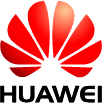
Huawei Proprietary and Confidential
Copyright © Huawei Technologies Co., Ltd.
HUAWEI HG552d Home Gateway
V100R001
User Guide
Issue
01
Date
2011-04-08
Part Number
202402

Huawei Proprietary and Confidential
Copyright © Huawei Technologies Co., Ltd.
Huawei Technologies Co., Ltd. provides customers with comprehensive technical
support and service. For any assistance, please contact our local office or company
headquarters.
Huawei Technologies Co., Ltd.
Address:
Huawei Industrial Base
Bantian, Longgang
Shenzhen 518129
People's Republic of China
Website:
http://www.huawei.com
Email:
terminal@huawei.com
Copyright © Huawei Technologies Co., Ltd. 2011. All rights reserved.
No part of this document may be reproduced or transmitted in any form or by
any means without prior written consent of Huawei Technologies Co., Ltd.
The product described in this manual may include copyrighted software of
Huawei Technologies Co., Ltd and possible licensors. Customers shall not in
any manner reproduce, distribute, modify, decompile, disassemble, decrypt,
extract, reverse engineer, lease, assign, or sublicense the said software, unless
such restrictions are prohibited by applicable laws or such actions are approved
by respective copyright holders under licenses.
Trademarks and Permissions
, HUAWEI, and are trademarks or registered trademarks of Huawei
Technologies Co., Ltd.
Other trademarks, product, service and company names mentioned are the
property of their respective owners.
Huawei Proprietary and Confidential
Copyright © Huawei Technologies Co., Ltd.
Notice
Some features of the product and its accessories described herein rely on the
software installed, capacities and settings of local network, and may not be
activated or may be limited by local network operators or network service
providers, thus the descriptions herein may not exactly match the product or its
accessories you purchase.
Huawei Technologies Co., Ltd reserves the right to change or modify any
information or specifications contained in this manual without prior notice or
obligation.
NO WARRANTY
THE CONTENTS OF THIS MANUAL ARE PROVIDED “AS IS”. EXCEPT AS
REQUIRED BY APPLICABLE LAWS, NO WARRANTIES OF ANY KIND,
EITHER EXPRESS OR IMPLIED, INCLUDING BUT NOT LIMITED TO, THE
IMPLIED WARRANTIES OF MERCHANTABILITY AND FITNESS FOR A
PARTICULAR PURPOSE, ARE MADE IN RELATION TO THE ACCURACY,
RELIABILITY OR CONTENTS OF THIS MANUAL.
TO THE MAXIMUM EXTENT PERMITTED BY APPLICABLE LAW, IN NO
CASE SHALL HUAWEI TECHNOLOGIES CO., LTD BE LIABLE FOR ANY
SPECIAL, INCIDENTAL, INDIRECT, OR CONSEQUENTIAL DAMAGES, OR
LOST PROFITS, BUSINESS, REVENUE, DATA, GOODWILL OR
ANTICIPATED SAVINGS.
Import and Export Regulations
Customers shall comply with all applicable export or import laws and regulations
and will obtain all necessary governmental permits and licenses in order to
export, re-export or import the product mentioned in this manual including the
software and technical data therein.

Contents
i
Contents
1 Safety Precautions.................................................................................................... 1
2 Product Overview .................................................................................................... 6
2.1 Product Features ......................................................................................................................... 6
2.2 Network Application .................................................................................................................. 7
2.3 Indicators, Interfaces and Buttons ............................................................................................. 8
2.3.1 Indicators .......................................................................................................................... 8
2.3.2 Interfaces and Buttons...................................................................................................... 9
2.4 System Requirements ...............................................................................................................11
3 Product Installation ............................................................................................... 12
3.1 Connecting the Cables .............................................................................................................12
3.2 Connecting the USB Interface .................................................................................................13
3.3 Getting Started ..........................................................................................................................13
4 Functions Introduction ......................................................................................... 14
4.1 Accessing the Web Configuration Page .................................................................................14
4.2 Restoring Default Settings .......................................................................................................14
5 Wireless Services.................................................................................................... 16
5.1 Configuring the Wireless Connection by the Web Page .......................................................16
5.2 Configuring the Wireless Connection by the WPS Button ...................................................17
6 Appendix ................................................................................................................. 18
6.1 Default Settings ........................................................................................................................18
6.2 Technical Specification ............................................................................................................18
7 FAQs ......................................................................................................................... 19
7.1 How can I configure a computer to use a static IP address? .................................................19
7.2 What can I do if I cannot visit Web sites through the terminal? ...........................................20
7.3 What can I do if the terminal cannot access the Internet through a wireless network adapter?
.........................................................................................................................................................21
7.4 What can I do if sometimes the terminal cannot access the Internet through a wireless
network adapter or if the WLAN connection is unsteady? ..........................................................22
7.5 What can I do if the WLAN of the terminal is not encrypted and the computer cannot access
the WLAN? .....................................................................................................................................23

Contents
ii
7.6 Is there any restriction on the number of the computers that access a WLAN through
wireless network adapters? ............................................................................................................23
7.7 What can I do if I cannot access the terminal configuration page?.......................................23
7.8 What can I do if Web pages often cannot be displayed during Web page browsing and can be
displayed after the terminal is restarted?.......................................................................................24
7.9 What can I do if noises exist during telephone calls? ............................................................24
7.10 After a broadband terminal is installed, does Internet access degrade call quality or do
telephone calls lower the Internet access rate? .............................................................................24

Figures
iii
Figures
Figure 2-1 Network application of the HG552d ....................................................................... 7
Figure 2-2 Indicators .................................................................................................................. 8
Figure 2-3 Interfaces and buttons ............................................................................................10
Figure 3-1 Connecting the HG552d ........................................................................................12
Figure 3-2 Connecting the USB Interface...............................................................................13
Tables
Table 2-1 Description of the elements for the network application diagram........................... 8
Table 2-2 Meanings of the indicators ......................................................................................... 9
Table 2-3 Functions of the interfaces and buttons ...................................................................10
Table 4-1 Requirements on PC settings ...................................................................................14

Safety Precautions
1
1 Safety Precautions
To use the device properly and safely, read these warnings and precautions carefully and
strictly observe them during operation. Unless otherwise specified, the term "device"
refers to the device and its accessories.
Basic Requirements
During storage, transportation, and operation of the device, keep it dry and prevent it
from colliding with other objects.
Do not dismantle the device. In case of any fault, contact an authorized service center
for assistance or repair.
Without authorization, no organization or individual can change the mechanical,
safety, or performance design of the device.
When using the device, observe all applicable laws and regulations and respect the
legal rights of other people.
Environmental Requirements for Using the Device
Before connecting and disconnecting cables, stop using the device, and then
disconnect it from the power supply. Ensure that your hands are dry during
operation.
Keep the device far from sources of heat and fire, such as a heater or a candle.
Keep the device far from electronic appliances that generate strong magnetic or
electric fields, such as a microwave oven or a refrigerator.
Place the device on a stable surface.
Place the device in a cool and well-ventilated indoor area. Do not expose the device
to direct sunlight. Use the device in an area with a temperature ranging from 0°C to
40°C.
Do not block the openings on the device with any object. Reserve a minimum space
of 10 cm around the device for heat dissipation.
Do not place any object (such as a candle or a water container) on the device. If any
foreign object or liquid enters the device, stop using the device immediately, power it
off, remove all the cables connected to it, and then contact an authorized service
center.
During thunderstorms, power off the device, and then remove all the cables
connected to it to prevent it from getting damaged due to lightning strikes.

Safety Precautions
2
Areas with Inflammables and Explosives
Do not use the device where inflammables or explosives are stored, for example, in a
gas station, oil depot, or chemical plant. Otherwise, explosions or fires may occur. In
addition, follow the instructions indicated in text or symbols.
Do not store or transport the device in the same box as inflammable liquids, gases, or
explosives.
Accessory Requirements
Use only the accessories supplied or authorized by the device manufacturer.
Otherwise, the performance of the device may get affected, the warranty for the
device or the laws and regulations related to telecommunications terminals may
become null and void, or an injury may occur.
Do not use the power adapter if its cable is damaged. Otherwise, electric shocks or
fires may occur.
Ensure that the power adapter meets the specifications indicated on the device
nameplate.
Ensure that the power adapter meets the requirements of Clause 2.5 in
IEC60950-1/EN60950-1 and it is tested and approved according to national or local
standards.
For pluggable device, the socket-outlet shall be installed near the device and shall be
easily accessible.
Safety of Children
Keep the device and its accessories out of the reach of children. Otherwise, they may
damage the device and its accessories by mistake, or they may swallow the small
components of the device, causing suffocation or other dangerous situations.
Maintenance
If the device is not used for a long time, power it off, and then remove all the cables
connected to it.
If any exception occurs, for example, if the device emits any smoke or unusual sound
or smell, stop using the device immediately, power it off, remove all the cables
connected to it, and then contact an authorized service center.
Do not trample, pull, or overbend any cable. Otherwise, the cable may get damaged,
causing malfunction of the device.
Before cleaning the device, stop using it, power it off, and then remove all the cables
connected to it.
Use a clean, soft, and dry cloth to clean the device shell. Do not use any cleaning
agent or spray to clean the device shell.
Disposal and Recycling Information
This symbol on the device (and any included batteries) indicates that the
device (and any included batteries) should not be disposed of as normal
household garbage. Do not dispose of your device or batteries as unsorted
municipal waste. The device (and any batteries) should be handed over to a

Safety Precautions
3
certified collection point for recycling or proper disposal at the end of its life.
For more detailed information about the recycling of the device or batteries, contact your
local city office, the household waste disposal service, or the retail store where you
purchased this device.
The disposal of this device is subject to the Waste from Electrical and Electronic
Equipment (WEEE) Directive of the European Union. The purpose for separating
WEEE and batteries from other waste is to minimize any environmental impact and
health hazard due to the presence of hazardous substances.
Reduction of Hazardous Substances
This device is compliant with the EU Registration, Evaluation, Authorisation and
Restriction of Chemicals (REACH) Regulation (Regulation No 1907/2006/EC of the
European Parliament and of the Council) and the EU Restriction of Hazardous
Substances (RoHS) Directive (Directive 2002/95/EC of the European Parliament and of
the Council). For more information about the REACH compliance of the device, visit the
Web site www.huaweidevice.com/certification. You are recommended to visit the Web
site regularly for up-to-date information.
EU Regulatory Conformance
This device should be installed and operated with a minimum distance of 20 cm between
the antenna and all persons.
Български:
1999/5/EC.
Česky
základním
Dansk: Huawei Technologies Co., Ltd. erklærer hermed at denne enhed er i
overensstemmelse med de obligatoriske krav og andre relevante bestemmelser i direktiv
1999/5/EF.
Nederlands: Hierbij verklaart Huawei Technologies Co., Ltd. dat dit apparaat in
overeenstemming is met de essentiële eisen en de andere relevante bepalingen van
richtlijn 1999/5/EC.
English: Hereby, Huawei Technologies Co., Ltd. declares that this device is in
compliance with the essential requirements and other relevant provisions of Directive
1999/5/EC.
Eesti: Käesolevaga kinnitab Huawei Technologies Co., Ltd., et see seade vastab
Direktiivi 1999/5/EÜ põhinõudmistele ja teistele asjakohastele määrustele.
Suomi: Huawei Technologies Co., Ltd. vakuuttaa täten, että tämä laite on
yhdenmukainen direktiivin 1999/5/EY olennaisten vaatimusten ja direktiivin muiden
asiaankuuluvien lausumien kanssa.
Français (Européen) : Le fabricant déclare que ce produit est conforme aux exigences
essentielles et aux autres dispositions pertinentes de la directive 1999/5/CE.

Safety Precautions
4
Deutsch: Huawei Technologies Co., Ltd. erklärt hiermit, dass dieses Produkt die
erforderlichen Bestimmungen und andere relevante Verordnungen der Richtlinie
1999/5/EG einhält.
Ελληνικά
Magyar: Jelen nyilatkozaton keresztül a Huawei Technologies Co., Ltd. kijelenti, hogy
a készülék megfelel az EC/5/1999 Irányelv összes lényeges követelményének és
Gaeilge: Fograíonn Huawei Technologies Co., Ltd leis seo go bhfuil an fheiste seo i
gcomhlíonadh leis na fíor-riachtanais agus na forálacha eile maidir le Treoir 1999/5/AE.
Italiano: Col presente documento, Huawei Technologies Co., Ltd. dichiara che questo
dispositivo è conforme ai requisiti essenziali e alle altre disposizioni applicabili della
Direttiva 1999/5/CE.
Latviski
Lietuviškai
s.
Malti: Hawnhekk, Huawei Technologies Co., Ltd. tiddikjara li dan it-
konformi mal-
1999/5/KE.
Polski: Wymieniona w tym dokumencie firma Huawei Technologies Co., Ltd. deklaruje,
Português (Europeu) : Deste modo, a Huawei Technologies Co., Ltd. declara que este
dispositivo está em conformidade com os requisitos essenciais e outras provisões
relevantes da Directiva 1999/5/CE.
Română
Slovenčina: Hua
Slovenščina: Huawei Technologies Co., Ltd. izjavlja, da je ta naprava v skladu z
bistvenimi zahtevami in dru
Español (Europeo) : Con el presente documento, Huawei Technologies Co., Ltd.
declara que este dispositivo cumple con los requisitos esenciales y con las demás
disposiciones correspondientes de la Directiva 1999/5/CE.
Svenska: Huawei Technologies Co., Ltd. förklarar härmed att denna produkt
överensstämmer med de grundläggande kraven och andra relevanta föreskrifter i direktiv
1999/5/EG.
For the declaration of conformity, visit the Web site
www.huaweidevice.com/certification.

Safety Precautions
5
Notice: Observe the national local regulations in the location where the device is to be
used. This device may be restricted for use in some or all member states of the European
Union (EU).
France: Outdoor use limited to 10 mW e.i.r.p. within the band 2454-2483.5 MHz.
Italy: For private use, a general authorisation is required if WAS/RLAN's are used
outside own premises. For public use, a general authorisation is required.
Luxembourg: General authorisation required for network and service supply.
Norway: This subsection does not apply for the geographical area within a radius of 20
km from the centre of Ny-Ålesund.
Federal Communications Commission (FCC) Statement
This device complies with part 15 of the FCC Rules. Operation is subject to the
following two conditions: (1) This device may not cause harmful interference, and (2)
this device must accept any interference received, including interference that may cause
undesired operation.
This device complies with part 68 of the FCC Rules.
This device should be installed and operated with a minimum distance of 20 cm between
the antenna and all persons.
Note: This equipment has been tested and found to comply with the limits for a Class B
digital device, pursuant to part 15 of the FCC Rules. These limits are designed to provide
reasonable protection against harmful interference in a residential installation. This
equipment generates, uses and can radiate radio frequency energy and, if not installed
and used in accordance with the instructions, may cause harmful interference to radio
communications. However, there is no guarantee that interference will not occur in a
particular installation. If this equipment does cause harmful interference to radio or
television reception, which can be determined by turning the equipment off and on, the
user is encouraged to try to correct the interference by one or more of the following
measures:
Reorient or relocate the receiving antenna.
Increase the separation between the equipment and receiver.
Connect the equipment into an outlet on a circuit different from that to which the
receiver is connected.
Consult the dealer or an experienced radio/TV technician for help.
Warning: Changes or modifications made to this device not expressly approved by
Huawei Technologies Co., Ltd. may void the FCC authorization to operate this device.

Product Overview
6
2 Product Overview
2.1 Product Features
The EchoLife HG552d (here in after referred to as the HG552d) is a high-performance
Asymmetrical Digital Subscriber Line (ADSL) voice gateway designed for home users
and small office and home office (SOHO) users. This section describes the features of
the HG552d.
Flexible Routing
Providing an embedded Point to Point Protocol over Ethernet (PPPoE) dialer
Supporting the Dynamic Host Configuration Protocol (DHCP) server
Supporting simultaneous multi-user access
Abundant Service Interfaces
Providing four high-speed Ethernet interfaces
Supporting the routing mode and the bridge mode
Providing the voice function through the Plain Old Telephone Service (POTS)
interface
Supporting the multi-service set identifier (MSSID) of Wireless Fidelity (WiFi),
which enables users to use wireless networks conveniently and securely
Providing mobile storage capability through the USB host interface
Outstanding Voice Functions
Providing VoIP service and T.38 facsimile service
Standard TR-069 Management Capability
Providing complete compatibility with the TR-069 standard of the Digital
Subscriber Line (DSL) Forum
Providing complete remote management and diagnosis
Providing a zero-configuration solution, which significantly lowers the operation
and maintenance costs and can be combined with the automatic upgrade and service
provisioning processes to conveniently distribute customized services
ADSL/ADSL2+ Interface
Providing embedded ADSL/ADSL2+ broadband network functions
Supporting the ITU-T G.994.1 (G.hs) handshake protocol
Providing compatibility with Annex A ANSI T1.413 Issue 2, ITU-T G.992.1
(G.dmt), G.992.3 (ADSL2), and G.992.5 (ADSL2+)
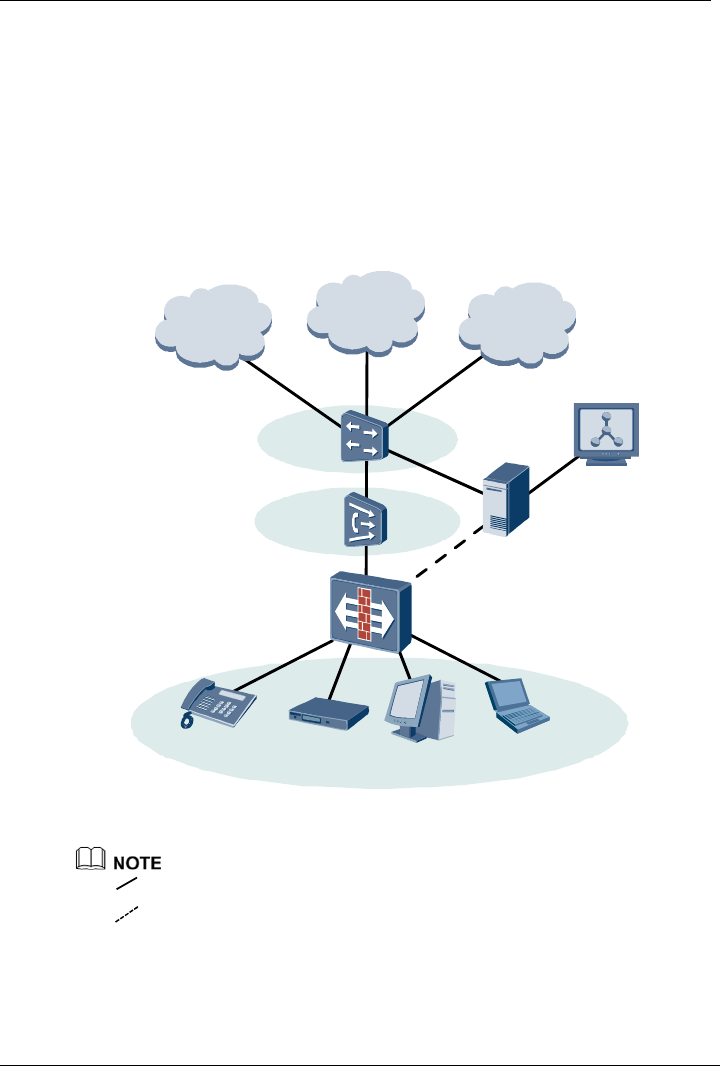
Product Overview
7
Wide Area Network (WAN) Protocol
Supporting multiple AAL5 protocols, such as LLC and VC-MUX (RFC1483/2684)
Supporting PPPoE (RFC2516)
Supporting routing and bridging in conformance with RFC 2684
2.2 Network Application
Figure 2-1 shows the network application of the HG552d.
Figure 2-1 Network application of the HG552d
2
9
8
11 12
7
4
5
3
1
6
10
: indicates an actual network connection.
: indicates a logical management channel.
Table 2-1 describes the elements shown in Figure 2-1.
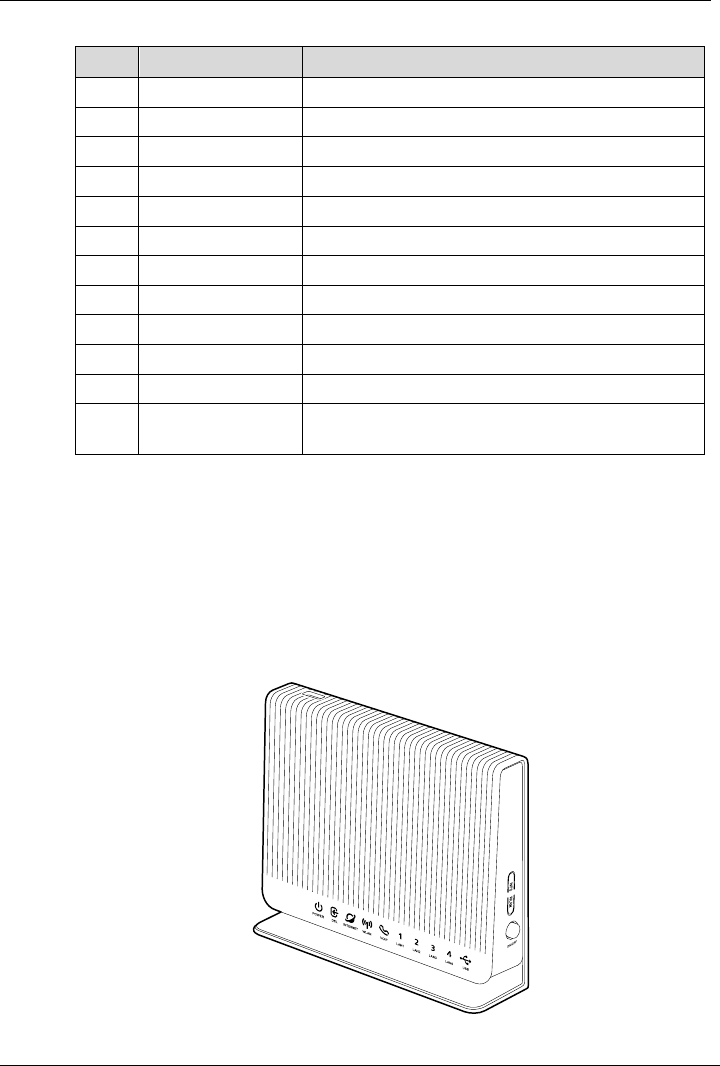
Product Overview
8
Table 2-1 Description of the elements for the network application diagram
No.
Item
Full Name
1
NGN
Next Generation Network
2
Internet
-
3
IPTV
Internet Protocol Television
4
BRAS
Broadband Remote Access Server
5
DSLAM
Digital Subscriber Line Access Multiplexer
6
OSS
Operations Support System
7
ACS
Auto-Configuration Server
8
HG552d
-
9
Telephone
-
10
STB
set-top box
11
Desktop computer
-
12
Notebook
computer
-
2.3 Indicators, Interfaces and Buttons
2.3.1 Indicators
The indicators of the HG552d are located on the front panel, as shown in Figure 2-2.
Figure 2-2 Indicators

Product Overview
9
Table 2-2 describes the meanings of the indicators.
Table 2-2 Meanings of the indicators
Indicator
Status
Description
POWER
On
The HG552d is powered on.
Off
The HG552d is powered off.
DSL
On
The DSL connection is established and activated.
Blinking
The DSL connection is being activated.
Off
The HG552d is powered off or faulty.
INTERNET
On
The Internet connection is set up, but no data is being
transmitted on the WAN interface.
Blinking
The Internet connection is set up, and data is being
transmitted.
Off
The HG552d is powered off or no Internet connection.
WLAN
On
The WLAN connection is successfully established but
no data is being transmitted.
Blinking
The WLAN connection is successfully established
and data is being transmitted.
Off
The HG552d is powered off or the WLAN connection
is not yet established.
VOIP
On
The softswitch has logged in successfully.
Off
The HG552d is powered off or no softswitch
connection.
LAN1, LAN2,
LAN3, LAN4
On
The LAN connection is successfully established but
no data is being transmitted.
Blinking
The LAN connection is successfully established and
data is being transmitted.
Off
The HG552d is powered off or the LAN connection is
not yet established.
USB
On
The USB connection is successfully established at
USB host mode but no data is being transmitted.
Blinking
The USB connection is successfully established at
USB host mode and data is being transmitted.
Off
The HG552d is powered off or the USB connection is
not yet established.
2.3.2 Interfaces and Buttons
The interfaces and buttons of the HG552d are located on the rear panel and side panel, as
shown in Figure 2-3.
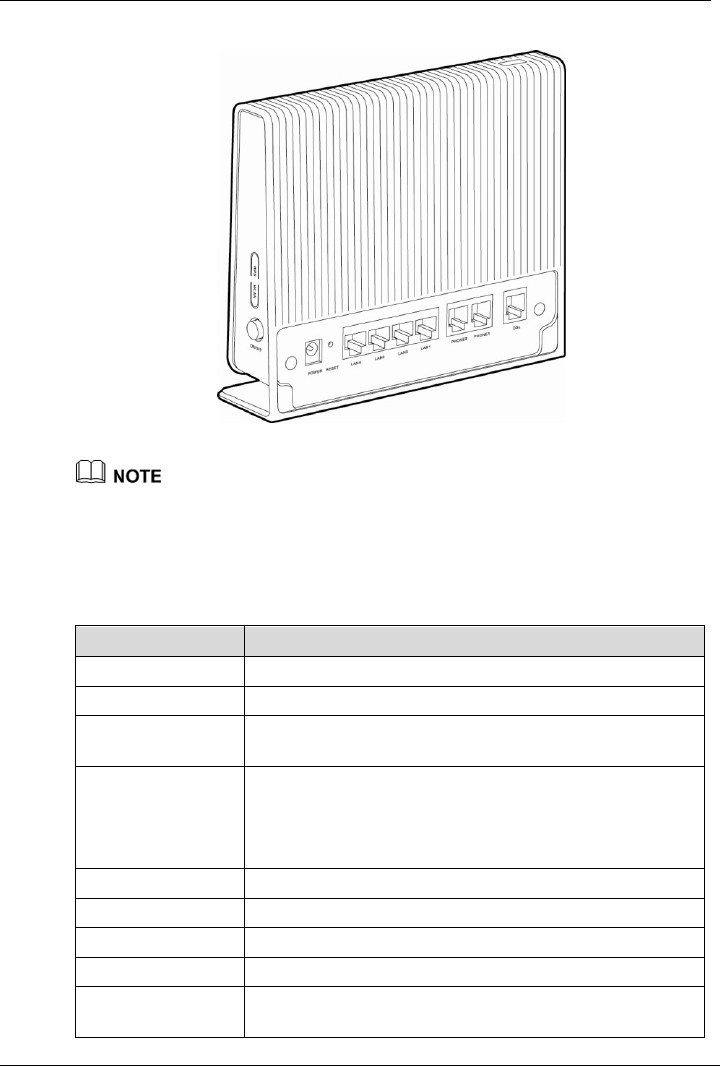
Product Overview
10
Figure 2-3 Interfaces and buttons
The USB interface is on the top of the HG552d.
The rear panel view and side panel view are for reference only. The actual
appearance may differ.
Table 2-3 lists the functions of the interfaces and buttons.
Table 2-3 Functions of the interfaces and buttons
Interface/Button
is used to…
DSL
connect the HG552d to the MODEM interface on the splitter.
PHONE1, PHONE2
connect the HG552d to the telephone.
LAN1, LAN2,
LAN3, LAN4
connect the HG552d to the Ethernet interface on the
computer or STB.
RESET
restore the factory settings of the HG552d.
NOTE
After you restore the default settings, the customized data will be
lost. Therefore, press the RESET button with caution.
POWER
connect the HG552d to the power adapter.
WLAN
enable or disable wireless network function quickly.
WPS
start the WPS negotiation of the HG552d.
ON/OFF
power on or off the HG552d.
USB (on the top of
the HG552d)
connect the USB device.

Product Overview
11
2.4 System Requirements
Make sure that the following requirements are met before using the HG552d.
Operating System Requirements
The operating system (OS) requirements are as follows:
Windows 98
Windows Me
Microsoft NT4
Windows 2000
Windows XP
Windows Vista
PC Hardware Configuration
The requirements for the hardware configuration of the device are as follows:
Memory: greater than 64 MB
Remaining space of disk C: greater than 128 MB
CD-ROM drive
Web Browser
Internet Explorer 6.0 or later versions, including FireFox 2.0
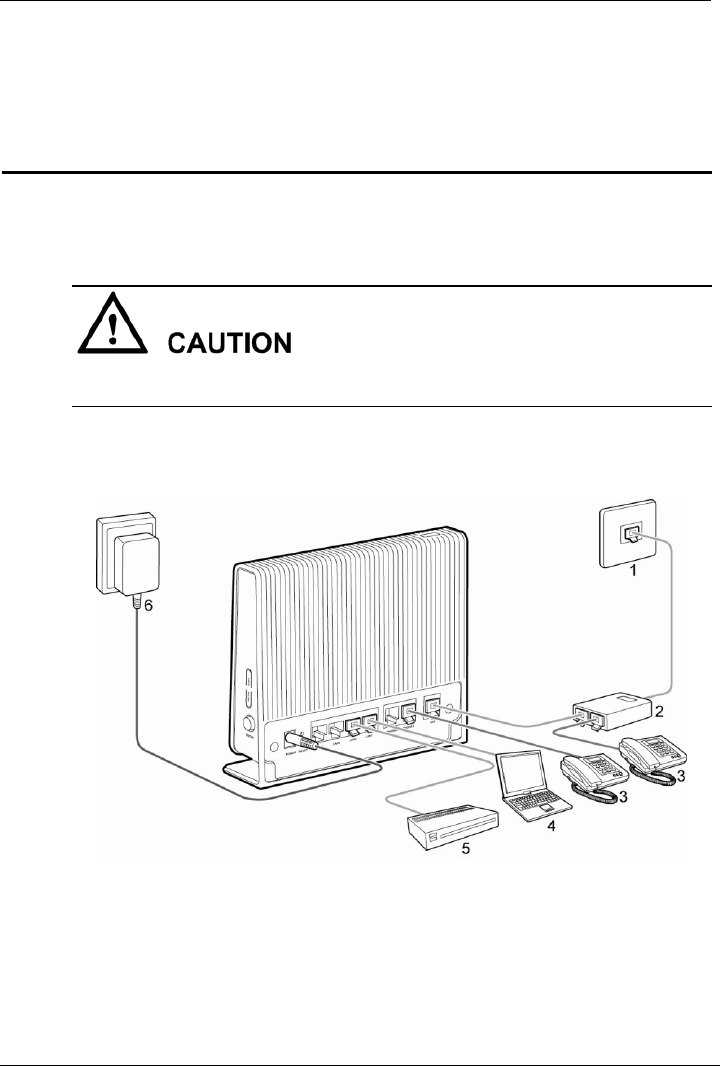
Product Installation
12
3 Product Installation
3.1 Connecting the Cables
Before connecting the cables, power off all equipment connected to it including the
HG552d, the PC, and the switch.
Connect the other equipment, such as the PC and the telephone, to the HG552d
according to Figure 3-1.
Figure 3-1 Connecting the HG552d
1
Telephone jack on the wall
2
Splitter
3
Telephone
4
Computer
5
Set-top box
6
Power adapter
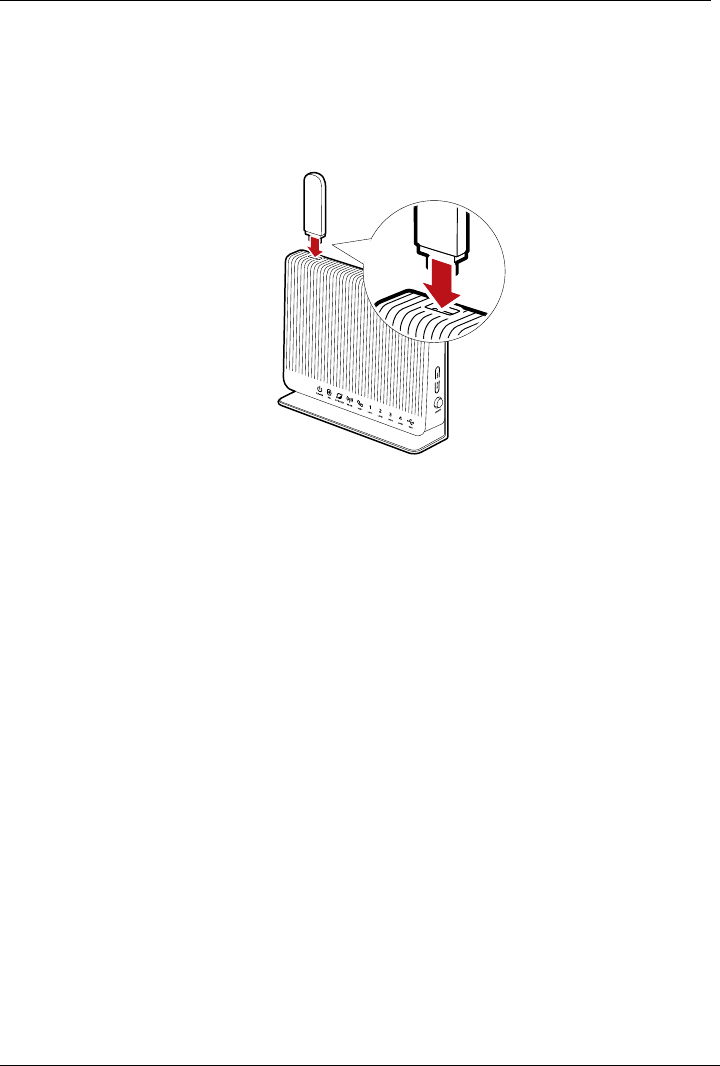
Product Installation
13
3.2 Connecting the USB Interface
The USB interface is on the top of the HG552d. Portable storage devices, such as USB
flash drives and portable hard disks, can be connected to the USB interface. For the
connection method, please see the following figure.
Figure 3-2 Connecting the USB Interface
3.3 Getting Started
To power on the HG552d, press the ON/OFF button on the side panel of the HG552d.
After you power on the HG552d, the DSL indicator blinks (for less than three minutes),
which indicates that the HG552d is being activated. Later, the DSL indicator turns solid
on. The POWER indicator is also solid on, which indicates that the HG552d is working
properly.

Functions Introduction
14
4 Functions Introduction
4.1 Accessing the Web Configuration Page
The HG552d provides simple and easy-to-use Web configuration pages, through which
you can check and configure the working parameters of the HG552d.
Before you log in to the Web configuration page of the HG552d, make sure the setting
requirements of the PC as listed in Table 4-1 are met.
Table 4-1 Requirements on PC settings
Item
Requirement
Network protocol
Enable the TCP/IP.
IP address and subnet mask of
the PC
Select Automatically obtain an IP address.
Internet Explorer
Do not use the proxy server.
To log in to the Web configuration page, do as follows:
Step 1 Start the Internet Explorer on the PC.
Step 2 Enter http://192.168.1.254 in the address bar of the Internet Explorer, and then press
Enter.
The Login dialog box is displayed.
Step 3 Enter the name and password in the Login dialog box, and then click OK.
By default, the user name and password is operator and justr34d.
4.2 Restoring Default Settings
You can quickly restore the default settings of the HG552d by pressing the RESET
button on the rear panel. To restore the default settings, press and hold the RESET
button for over six seconds after the HG552d is powered on, and then release the button.
In addition, you can restore the default settings of the HG552d through the Web-based
configuration utility. To restore the default settings through the Web-based configuration
utility, do as follows:
Step 1 Log in to the Web-based configuration utility.
Step 2 Choose Maintenance > Device in the navigation tree.

Functions Introduction
15
Step 3 Click Restore Default Settings button.
After the preceding operations, the page jumps to the login page. You can log in to the
Web-based configuration utility by entering the default user name and password. You
can get them from the print label on the back panel of the shell.

Wireless Services
16
5 Wireless Services
If a wireless network adapter is installed on your computer, you can connect your
computer to the HG552d through a wireless connection.
There are two methods to configure the wireless network connection.
5.1 Configuring the Wireless Connection by the Web
Page
To configure the wireless network connection by configuring the web page, do as
follows:
Step 1 Set the wireless network name and access password of the HG552d (taking the
authentication type WPA-PSK as an example):
1. Log in to the Web-based configuration utility.
2. In the navigation tree on the left, choose Basic > WLAN.
3. Ensure select the Enable WLAN option button.
4. Enter a wireless network name in the SSID text box.
5. Select WPA-PSK from the Security Mode drop-down combo box.
6. Enter an access password in the WPA pre-shared Key text box.
7. Select TKIP from the WPA Encryption drop-down combo box, and keep the
default settings of other parameters.
8. Click Submit to save the settings.
Step 2 Enable the wireless configuration service provided by Windows XP.
1. Right-click My Computer, and then choose Manage from the shortcut menu.
2. In the Computer Management window, choose Computer Management
(Local) > Services and Applications >Services.
3. From the services listed in the right pane of the Computer Management window,
right-click Wireless Zero Configuration, and then choose Properties from the
shortcut menu.
4. In the Wireless Zero Configuration Properties (Local Computer) dialog box,
check whether Service status is Started. If not, click Start.
5. Click OK to close the dialog box, and then close the Computer Management
window.
Step 3 Configure the wireless network connection on your computer (taking the Windows XP
operating system as an example):
1. Choose Start > All Programs > Accessories > Communications > Network
Connections.

Wireless Services
17
2. In the Network Connections window, right-click Wireless Network Connection to
display a shortcut menu, and then select View Available Wireless Networks from
the shortcut menu.
3. Select the wireless network that is configured in Step 1 from the wireless network list,
and then click Connect in the lower right corner of the window.
4. In the displayed dialog box, enter the access password that is preset in Step 1, and
then click Connect.
After the password is verified, Connected appears on the icon of the wireless network in
the wireless network list, which indicates that your computer is connected to the
HG552d through wireless connection.
5.2 Configuring the Wireless Connection by the WPS
Button
If the wireless network adapter on your computer supports the WPS function, you can
connect your computer to the HG552d wirelessly as follows:
Step 1 Set the WLAN parameters of HG552d, and then set the Security to WPA-PSK,
WPA2-PSK or WPA-PSK/WPA2-PSK as prompted. For details, see the Step1 of
chapter 5.1 "Configuring the Wireless Connection by the Web Page."
The WPS function can be used only when the security mode of the WLAN is set to WPA-PSK,
WPA2-PSK, or WPA-PSK/WPA2-PSK.
Step 2 Press the WPS button on the side panel to start the WPS negotiation of the HG552d.
Then the WPS indicator of the HG552d blinks.
Step 3 Enable the WPS negotiation function of the wireless network adapter within 2 minutes.
Wait for a few seconds, and then you can see the WPS indicator becomes solid on from
the blinking state, indicating that the HG552d is connected to your PC through the WPS
function. This state lasts 5 minutes. Then the WPS indicator turns off.

Appendix
18
6 Appendix
6.1 Default Settings
Parameter
Setting
IP address of the LAN interface
192.168.1.254
Subnet mask of the LAN interface
255.255.255.0
User name used for logging in to the
Web configuration page
operator
Password used for logging in to the
Web configuration page
justr34d
Wireless network function
Enable
6.2 Technical Specification
Item
Specification
Power supply
12 V DC, 1.5 A
Power consumption
< 18 W
Ambient temperature for
operation
0°C to 40°C(32°F to 104°F)
Relative humidity for
operation
5% to 95%, non-condensing
Dimensions (L × W × H)
173 mm × 48 mm × 146.5 mm
Weight
< 500g
Standards
DSL standards
ADSL, ADSL2 and ADSL2+
WLAN standards
802.11b, 802.11g and 802.11n

FAQs
19
7 FAQs
7.1 How can I configure a computer to use a static IP
address?
Take a computer that runs Windows XP as an example. To configure the computer to use
a static IP address, do as follows:
Step 1 In the Control Panel window, double-click Network Connections to display the
Network Connections window.
Step 2 In the Network Connections window, right-click the working Local Area Connection
and choose Properties.
Step 3 In the This connection uses the following items group box of the Local Area
Connection Properties dialog box, select Internet Protocol (TCP/IP). Click
Properties.
Step 4 Select Use the following IP address.
Step 5 Set the IP address of the computer and ensure that the IP address is in the same network
segment as the local area network (LAN) IP address of the terminal.
Assume that the default LAN IP address of the terminal is 192.168.1.254. To set the IP
address of the computer, do as follows:
1. In IP address, enter 192.168.1.100. Ensure that this IP address is unique and not
used by other computers.
The configurable static IP address ranges from 192.168.1.1 to 192.168.1.253.
2. In Subnet mask, enter 255.255.255.0.
3. In Default gateway, enter 192.168.1.254.
Step 6 Consult your network service provider about the IP address of the domain name server
(DNS). In Preferred DNS server and Alternate DNS server, enter the IP address.
If you configure the static IP address for the purposes of accessing the Web
configuration page of the terminal, you can skip this step.
Step 7 In the Internet Protocol (TCP/IP) Properties dialog box, click OK. Then in the Local
Area Connection Properties dialog box, click OK.

FAQs
20
7.2 What can I do if I cannot visit Web sites through
the terminal?
Step 1 Check whether the POWER indicator of the terminal is on.
If the POWER indicator is off, perform further checks as follows:
1. Ensure that the power switch of the terminal is turned on.
2. Ensure that electricity comes from the socket and that the input power of the socket
meets the requirements described on the label of the terminal power adapter. If the
voltage is unsteady, for example, if the voltage is too high or too low, do not use the
terminal. Wait until the voltage restores to its normal level, and then use the terminal.
3. Ensure that the terminal is properly connected to the socket through the power
adapter.
If the POWER indicator is still off, contact an authorized maintenance center.
Step 2 After powering on the terminal, wait for about three minutes. Then check whether the
DSL indicator of the terminal is on.
If the DSL indicator blinks for a long time, perform further checks as follows:
1. Ensure that telephone lines are properly connected. Especially ensure that the
telephone line connecting to the splitter is properly connected.
2. Ensure that terminal cables or telephone lines are far from the electric appliances that
generate strong magnetic or electric fields.
3. Replace telephone lines.
If the DSL indicator still blinks, contact your network service provider.
Step 3 Check whether the LAN indicator of the terminal is on.
If the LAN indicator is off, perform further checks as follows:
1. Ensure that the network adapter of the computer is enabled.
2. Ensure that the network cable between the terminal and the computer is properly
connected.
3. Remove and then insert the network cable or replace the network cable.
If the LAN indicator is still off, contact an authorized maintenance center.
Step 4 Check whether the driver for the network adapter is properly installed.
Take a computer that runs Windows XP as an example. To check whether the driver for
the network adapter is installed, do as follows:
1. On the desktop, right-click My Computer and choose Manage.
2. In the navigation tree of the Computer Management window, choose Device
Manager.
3. In the right pane of the Computer Management window, click Network adapters
to view the information about the network adapter of the computer.
If no network adapter is detected or if a question mark (?) or an exclamation mark (!) is
displayed next to the icon of the network adapter, you can infer that the driver for the
network adapter is not properly installed. In this case, re-install the driver for the network
adapter of the computer.

FAQs
21
For details about how to set the parameters, see the description of the PPP dialing
software.
Step 5 Ensure that you have entered the correct user name and user password that are required
by the PPP dialing software.
The user name and the user password are provided by your network service provider.
Step 6 Check whether you can use the PPP dialing software to dial successfully.
If you cannot use the PPP dialing software to dial successfully, perform further checks as
follows:
1. Stop the PPP dialing software and then power off the terminal. After five minutes,
power on the terminal and use the PPP dialing software to dial again.
2. Restore the default settings of the terminal.
If the problem persists, contact your network service provider.
Step 7 Check whether the proxy server of the Web browser is correctly configured. Take the
Internet Explorer installed on a computer that runs Windows XP as an example. To
check whether the proxy server of the Web browser is correctly configured, do as
follows:
1. Start the Internet Explorer.
2. Choose Tools > Internet Options.
3. In the Internet Options dialog box, click the Connections tab.
4. In the Local Area Network (LAN) settings group box, click LAN settings.
5. In the Proxy server group box of the Local Area Network (LAN) Settings dialog
box, ensure that Use a proxy server for your LAN (These settings will not apply
to dial-up or VPN connections) is not selected.
Step 8 Try to access multiple other Web sites to check whether the terminal can access.
If the terminal still cannot access other Web sites, contact your network service provider.
7.3 What can I do if the terminal cannot access the
Internet through a wireless network adapter?
Step 1 Ensure that the power cables and telephone lines of the terminal are properly connected.
Step 2 Check whether the WIFI indicator of the terminal is on.
If the WIFI indicator is off, you can infer that the wireless local area network (WLAN)
function of the terminal is disabled. In this case, enable the WLAN function.
For details about how to enable the WLAN function, see the manual of the terminal.
Step 3 See the description of the wireless network adapter that is installed on the computer and
check whether the wireless network adapter supports the 802.11b and 802.11g protocols.
If the wireless network adapter does not support the 802.11b and 802.11g protocols,
replace it with the network adapter that supports the protocols.
Step 4 Check whether the driver for the wireless network adapter is properly installed on the
computer.

FAQs
22
If the driver is improperly installed, install it properly.
Step 5 Check whether the computer can receive the signals of a WLAN.
Take a computer that runs Windows XP as an example. To check whether the computer
can receive the signals of a WLAN, do as follows:
1. In the Control Panel window, double-click Network Connections to display the
Network Connections window.
2. In the Network Connections window, right-click Wireless Network Connection
and choose View Available Wireless Network.
If the computer cannot detect a WLAN, place the computer close to the terminal and
ensure that no obstacles such as cement or wooden walls are present between the
wireless client and the terminal.
Step 6 Check whether the computer accesses the WLAN of the terminal successfully.
Check the list of wireless network connections and ensure that the terminal is connected
to the WLAN.
Step 7 Check whether you can use the PPP dialing software to dial successfully.
Step 8 Try to access multiple Web sites to check whether the terminal can access other Web
sites.
If the terminal cannot access other Web sites either, restore the default settings of the
terminal. If the problem persists, contact your network service provider.
7.4 What can I do if sometimes the terminal cannot
access the Internet through a wireless network adapter
or if the WLAN connection is unsteady?
Step 1 Check the positions of your terminal and computer. Ensure that they are far from the
electric appliances such as microwave ovens, refrigerators, or cordless telephones that
generate strong magnetic or electric fields.
Step 2 Place your terminal in an open position.
Although radio signals can pass through obstacles, the transmission effects of WLAN
radio signals are affected if radio signals pass through too many obstacles such as cement
or wooden walls.
Step 3 Place your computer close to your terminal.
If your computer is far from your terminal, the effects of the WLAN are affected.
Step 4 Place your terminal and computer in another direction.
Step 5 Do not use your terminal to access a WLAN during thunderstorms.

FAQs
23
7.5 What can I do if the WLAN of the terminal is not
encrypted and the computer cannot access the WLAN?
Step 1 Delete the settings of wireless network connections from your computer.
Take a computer that runs Windows XP as an example. To delete the settings of wireless
network connections, do as follows:
1. In the Control Panel window, double-click Network Connections to display the
Network Connections window.
2. In the Network Connections window, right-click Wireless Network Connection
and choose Properties.
3. In the Wireless Network Connection Properties dialog box, click the Wireless
Networks tab.
4. In the Preferred Networks group box, select the latest wireless network connection
saved on your computer. Then click Remove.
5. Delete all the other wireless network connections from the Preferred Networks
group box.
6. Click OK.
Step 2 Create a wireless network connection that is not encrypted.
7.6 Is there any restriction on the number of the
computers that access a WLAN through wireless
network adapters?
Theoretically, the terminal supports hundreds of concurrent computers that access the
Internet through wireless network adapters. In practical applications, for the purposes of
the high performance of a wireless network, the number of the concurrent computers that
connect to the terminal should not exceed five.
7.7 What can I do if I cannot access the terminal
configuration page?
Step 1 See the answer to 7.2 "What can I do if I cannot visit Web sites through the terminal?"
and ensure that the power supply of the terminal works properly and that the telephone
lines and network cables of the terminal are properly connected.
Step 2 Check the IP address of your computer and ensure that this IP address is in the same
network segment as the LAN IP address of the terminal.
Step 3 Ensure that your Web browser does not use a proxy server.
Step 4 Ensure that you have entered the correct user name and user password that are used for
accessing the terminal configuration page.
Step 5 If the problem persists, restore the default settings of the terminal.

FAQs
24
7.8 What can I do if Web pages often cannot be
displayed during Web page browsing and can be
displayed after the terminal is restarted?
Step 1 Ensure that the terminal and other devices such as telephones or fax machines are
connected to the telephone line through a splitter.
For details about how to install a splitter, see the related description in the manual.
Step 2 Ensure that telephone lines are properly connected.
If the telephone lines are improperly connected, the stability of the network connection is
affected.
Step 3 Check the positions of your terminal and computer. Ensure that they are far from the
electric appliances such as microwave ovens, refrigerators, or cordless telephones that
generate strong magnetic or electric fields.
If the problem persists, contact your service provider.
7.9 What can I do if noises exist during telephone calls?
Step 1 Ensure that a splitter is installed.
A splitter helps to protect the call quality of the asymmetric digital subscriber line
(ADSL) from being affected due to the interference of other type of signals.
Step 2 Ensure that telephone lines are properly connected. Especially ensure that the telephone
line connecting to the splitter is properly connected.
Step 3 Replace telephone lines and ensure that the telephone lines are not faulty.
7.10 After a broadband terminal is installed, does
Internet access degrade call quality or do telephone
calls lower the Internet access rate?
No. The terminal uses the frequency division multiplexing (FDM) and splitter
technologies to separate voice signals from data signals. Although the two types of
signals are transmitted through one telephone line, they are carried by different
frequency bands. Therefore, they do not interfere with each other. In this case, you can
make a telephone call and access the Internet at the same time, without degrading call
quality or lowering the Internet access rate.
HUAWEI TECHNOLOGIES CO., LTD.
Huawei Industrial Base
Bantian, Longgang
Shenzhen 518129
People's Republic of China
www.huawei.com
Part Numbe:202402